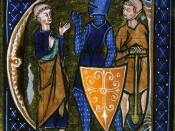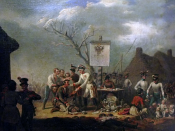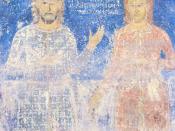In the medieval period the most powerful people in the Western Europe were the great nobleÃÂs kings, lords and the lesser nobles. They were at the top of the feudal system.Nobles had control over the knights and peasants. Kings and queens found it difficult to rule without the help of the nobles for three main reasons. Firstly they needed the force of fighting men (knights) on call if their power was threatened, Secondly they needed someone to travel their messages it was hard for rulers to make their power felt in distant parts and lastly they needed someone to look after the manor this meant hiring peasants (serfs)to farm the land. In return nobles were given a great deal of power, land, money and life of luxury.
NobleÃÂs had many roles in the medieval period but their main roles were; collecting taxes from people (peasants) who lived on their manor, to run manor courts for the peasants that broke the rules e.g.
if a peasant didnÃÂt pay their fee (tax), protecting whom lived on the manor, fighting in wars and providing soldiers to fight in wars. In return the rulers (kings and queens) gave them a fief (a ruler giving a great deal of manor (land), control over people who lived on the manor and great deal of power). Nobles had to support the king by coming to fight with a number of supporters (knights).they would hire knights to be their supporters. knights would come to fight when it was needed .In return the nobles provided them with their needs. The nobles owned everything on the manor including the peasant that worked on the manor .lords who owned a large manor and had a great deal of power were called ÃÂthe stewardsÃÂ. The stewards hired bailiffs to be their representative. Bailiff and peasants would decide on a reeve, wealthy peasant to supervise them and keep account of all the crops .the peasants would farm the land and In return the nobles would let the peasants live on the manor and use the facilities on the manor but with an exception that the peasants would obey the manors rules. If a peasant didnÃÂt obey the manors rules they would be sent to a manors court where they would be decided on a punishment sometimes even sentenced to death .. Nobles in the medieval period were powerful and had control over people because they were wealthy however in the present time nobles are people who just achieve great things in life e.g. sir Elton john is a noble because he has achieved great heights in the music industry, people respect him because he is a great singer.
Noble woman were know as ladies, their role in the medieval life was to get married to a noble man. Noble woman didnÃÂt have a choice on who they would marry as they were their fatherÃÂs possession. Noble woman and man never married for love it was all up to their parents on who they would marry as it was an arranged marriage .the girlÃÂs family would offer their daughter to the future groomÃÂs parents and in some cases the future groom was able to choose his own bride. Once the future grooms parent accepted their offer the two families had to reach an agreement on a dowry (brides families possession including their castle, land, money and serfs given to the groom this is a e.g. large dowry).sometimes the groom and the bride would be as young as 12 but usually the bride was a several years younger than the groom. In some cases the groom would be old as 50 and the bride young as 12.the wedding would be held in a church where the bride they get married and the husband now has complete control over the wife and her familyÃÂs possessions. The husband is the head of the household and his wife is his possession so he is allowed to beat her as long as she does not die and he may divorce her anytime for any reason. Ladies role in the medieval period was to have babies every year from the age of 14 to her mid 30s, it was important to have sons to inherit the families possessions land and the family name she was also responsible of running a busy household she planned meals, ordered supplies, supervised her servants (She didnÃÂt have to cook or clean as she had lots of servants.) , when her husband was away doing his duties she was responsible of running the manor and she would have ladies in-waiting come to her home and learn lady like manners and skills. Noble families preferred sons instead of daughters since boys would carry on the family name as opposed to girls who carried a large dowry when they married. When Noble children were born they would stay with a wet nurse until the age of 2 at that stage theyÃÂre able to walk and talk, they return home where they are cared for by their mothers and nurses at around the age of 7, noble boys were sent to a lords castle to train as a knight if the boy was physically weak then he was sent to a monastery to become a monk or a scholar. Noble girls were sent to a ladies castle where they learned how to manage a household, care for children, weave, sew, play instruments, dance, sing and how be a lady. Noble children were also taught rudimentary manners and a bit of writing, reading and dancing by their parents or tutors. Noble children had a lot of toys to play with.
Many wars were fought in the middle ages .the nobles lived in castles to protect themselves .nobles built castles that had two grand stone walls within those walls, was a building called a keep where the noble family lived. All keeps were at least four stories .the ground level had the dungeon, cellar, store room and well to provide fresh water, the second floor had a chapel and a guard room, third floor had the great hall and built in toilet on the outer wall and the fourth floor had the guests bedroom and a sleeping quarter for the nobles family. The nobles built the two grand stone walls to protect themselves, their families, servants, supporters and their serfs (peasants that work on the manor) from possible attack. Every castle had servants which cleaned and cooked for the noble family, all castles had knights who defended the castle against attack. The upper floors were the sitting rooms where the family would rest, play games and talk. Nobles had guests come and visit their castles for several days, nobles would hold a huge feast at the great hall containing of great meals and entertainment.
Nobles showed their wealth by eating variety of foods they enjoyed a variety of meats, breads, vegetables ,spices (from the far east) and they had one chief (servant whose job was to cook and supervise the kitchen) to create magnificent meals for the noble family. And when their guests came to visit the chief would make extraordinary meals that were either mush to be scooped up with a piece of bread or solid chunks to be eaten by hand they did this because they didnÃÂt have any utensils for eating, they used stale Pisces of bread for plates and had to share that with several other people and they didnÃÂt have a cup either so they shared the wine bottle or ale around the table. While the guests were feasting upon the fantastic meals the performers; musicians, jester and jugglers were performing for the guests. One of their favourite forms of entertainment was a contest called jousting. Jousting was when two men riding on horseback holding long lances would charge at each other and try to knock one another off. Nobles had many hobbies but they mostly enjoyed hunting and falconry. Nobles kept the forest to themselves so they were the only ones allowed by law to kill a fellow animal. Hunting was a sport many noble men and women hunted for fun. Noblemen also hunted towards training for wars and also did fencing. Falconry was a popular sport each castle had a falconer whose job was to train and care for the hawk as if it was a human being. A good hawk would quickly sight down prey and kill it. Nobles also liked playing ball and stick, broad jumping, archery, putting stone and nobles enjoyed playing chess, backgammon and checkers. Nobles wore brighter colours, better materials and longer jacket and sleeve lengths to show off their great wealth. Their clothing was made of silk, velvet, damask (a heavy cloth) and fur (only used for linings and trimmings). Noble women wore elaborate dresses, head garments and jewellery to show off their wealth. Noble Women wore many layers of clothes to keep warm. Their main dress was called a kirtel. They had long pointy sleeves with hoops at the end which they attached to their middle finger the keep the sleeves down. Their overskirt dragged on the ground and they wore a belt with bells hanging from it. They also wore barrettes, caps with nets that held their hair in place and wore scarves that wrapped around the head and throat. Noblemen were exquisite jackets, cloaks, surcoats and shoes.
Nobleman wore trousers covered with long over tunics called bliauds. Tabards and Surcoats were also worn. These clothes were covered with full length cloaks. The cloaks were trimmed with an expensive fur and pinned at the shoulder with a broach. They wore shoes made of silk, velvet, cloth or leather and fastened with a buckleNobles were the most powerful group in society. They had power, money and fiefs. Kings and queens were not able to rule without the help of the nobles. Nobility came with a great deal of power over given by the king and queen through the feudal system. NobleÃÂs role in the medieval life was to support the king, fight in wars and run the manor. A small price to pay for a life of luxury.
Bibliography1.Cels, S. (2005) Life on a medieval manor, Canada: Cabtree publishing company.
2.Eastwood, k. (1993) The Middle Ages, London: romlyn childhood books.
3.Howarth, S. (2004) Medieval Society, Canada: cabtree publishing company.
Internet References:ÃÂBrooke, Christopher. The Structure of Medieval Society. McGraw-Hill Book Company. New York. 1971.
ÃÂCarrol, Sharon. Women's Clothing in the middle Ages. http://www.millersv.edu/~english/homepage/duncan/medfem/cloth.html.
ÃÂGies, Frances and Joseph. Marriage and Family in the middle Ages. Harper and Row. New York. 1987ÃÂGravett, Christopher. The World of the Medieval Knight. Peter Bedrick Books. New York.1996.
ÃÂMacdonald, Fiona. The middle Ages. Silver Burdett Company. 1984.
ÃÂOakes, Catherine. Exploring the Past: the middle Ages. The Hamlyn Publishing Group. 1989.
ÃÂReynolds, Laura. Marriage in the middle Ages. http://www.millersv.edu/~english/homepage/duncan/medfem/marriage.html Reynolds, Laura. Marriage in the middle Ages II. http://www.millersv.edu/~english/homepage/duncan/medfem/marr.htmlÃÂSobol, Donald J. The First Book of Medieval Man. Franklin, Inc. New York. 1959.
ÃÂStiles, Ben. Clothing Makes the Woman. http://www.millersv.edu/~english/homepage/duncan/medfem/clothing.html.
ÃÂShahar, Shulamith. Childhood in the middle Ages. Routledge, Chapman, and Hall Inc. New York. 1992.
ÃÂSmith, Rebecca. The Medieval Childhood. http://www.millersv.edu/~english/homepage/duncan/medfem/rlspaper.htmlÃÂThe Middle Ages--Clothing. http://www.learner.org/exhibits/middleages/clothing.htmlÃÂWincovitch, Christy. A Little about Wet Nurses. http://www.millersv.edu/~english/homepage/duncan/medfem/wet.htmlBy paniz sadeghiEastwood, k. (1993) The Middle Ages,London: romlyn childhood books.
The titles of the 2 pages were ÃÂthe noble lifeÃÂ. This book had 2 pages about the noble life, which helped me in my research. It gave me useful information about the noble life. I learned a lot of things from the 2 pages about the nobles. The writer has written the 2 pages on the noble life on what she knows about them so itÃÂs coming from her perspective of the nobles but she has researched the nobles before writing these 2 pages. This is a reliable source because itÃÂs a book so itÃÂs a primary source but itÃÂs not so reliable because it was published in 1993 but it was a critical source in my research.
The file is attached with the assignment.





